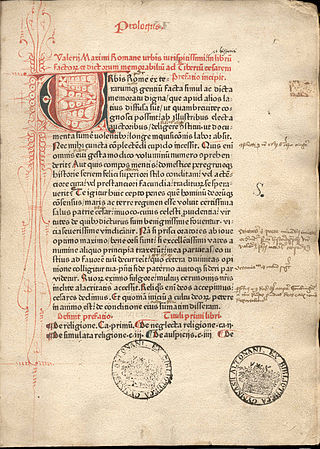
An incunable or incunabulum is a book, pamphlet, or broadside that was printed in the earliest stages of printing in Europe, up to the year 1500. The specific date is essentially arbitrary, but the number of printed book editions exploded in the following century, so that all incunabula, produced before the printing press became widespread in Europe, are rare, where even some early 16th-century books are relatively common.
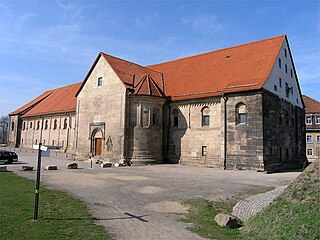
Basil Valentine is the Anglicised version of the name Basilius Valentinus, ostensibly a 15th-century alchemist, possibly Canon of the Benedictine Priory of Saint Peter in Erfurt, Germany but more likely a pseudonym used by one or several 16th-century German authors.
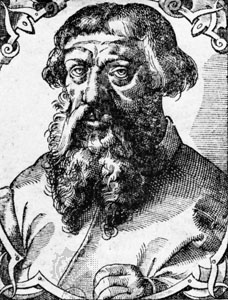
Étienne Dolet was a French scholar, translator and printer. He was a controversial figure throughout his lifetime, which was buffeted by the opposing forces of the Renaissance and the French Inquisition. His early attacks upon the Inquisition and the municipal authorities of Toulouse, together with his later publications in Lyon, caused the French Inquisition to monitor his activities closely. After several stays in prison, the combined efforts of the parlement of Paris, the Inquisition, and the theological faculty of the Sorbonne resulted in his conviction for heresy and a death sentence. He was hung and burned with his books on the Place Maubert in Paris. In modern times, Dolet is remembered as a martyr for what is now known as freedom of speech and freedom of the press.
This article is a list of the literary events and publications in the 15th century.
This article presents lists of literary events and publications in the 16th century.
This article contains information about the literary events and publications of 1540.

The year 1759 in science and technology involved several significant events.

Vannoccio Biringuccio, sometimes spelled Vannocio Biringuccio, was an Italian metallurgist. He is best known for his manual on metalworking, De la pirotechnia, published posthumously in 1540.

Sebastian Gryphius was the head of a printing house in Lyon and a humanist.
Richard Eden was an English alchemist and translator. His translations of the geographical works of other writers helped to foster enthusiasm for overseas exploration in Tudor England.
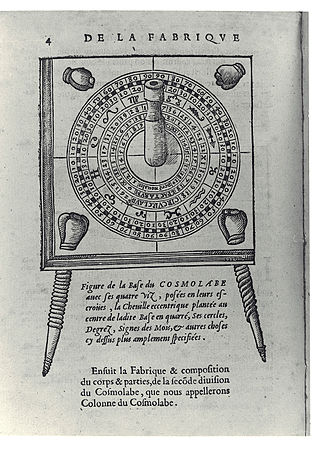
Jacques Besson (1540?–1573) was a French Protestant inventor, mathematician, and philosopher, chiefly remembered for his popular treatise on machines Theatrum Instrumentorum (1571–1572), which saw many reprints in different languages.
The decade of the 1530s in music involved some significant events, publications, compositions, births, and deaths.
Events from the 1540s in England.
Nationality words link to articles with information on the nation's poetry or literature.
Nationality words link to articles with information on the nation's poetry or literature.

Thomas Raynalde was an English physician, known as the translator or editor of Eucharius Rösslin's De Partu Hominis. The translation was published as The Byrth of Mankynde, otherwyse named The Womans Booke in 1545 and was highly successful, running to eleven or thirteen editions and remaining in use until 1654. A Compendious Declaration of the Excellent Vertues of a Certain Lateli Inventid Oile, published in 1551, is believed to have been written by the same person.
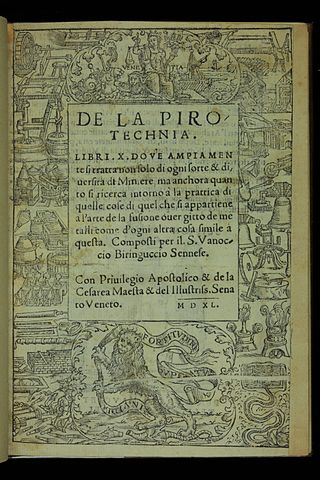
De la Pirotechnia is considered to be one of the first printed books on metallurgy to have been published in Europe. It was written in Italian and first published in Venice in 1540. The author was Vannoccio Biringuccio, a citizen of Siena, Italy, who died before it was published. Further editions were published in 1550, 1558, 1559, and 1678, with a (sloppy) French translation by Jacques Vincent being published in 1556, 1572, and 1627. Parts were translated into Latin, English and Spanish at various times in the 1550s and 1560s, generally without acknowledgement. The second book on metallurgy, De re metallica, was written in Latin by Georgius Agricola, and published in 1556.
The year 1536 in science and technology included a number of events, some of which are listed here.
Martha Gnudi, née Teach was an American medical historian and translator.
Bernardo Perez de Vargas was a Spanish writer on several topics. He translated and wrote works in astronomy, alchemy and on mining. His most important work, De re metalica (1569), was on mining and metallurgy and drew extensively from previously published works in other language. He titled himself as "magnífico caballero" but very little is known about him.









